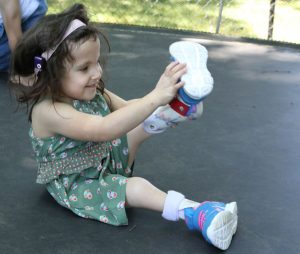
Physical therapist may see children or adults with SA/CRS for a number of reasons, including development of mobility skills, stretching of contractions, wheelchair seating consultation, and school access recommendations. In each case, there are some specific factors about SA/CRS to keep in mind.
MOBILITY SKILLS
Wheelchair skills This link lists wheelchair skills from basic to elite and approximate age of development for those with SA/CRS who are wheelchair users either full or part time.
Walking skills This link may be a helpful resource for parents explaining and showing a video of the developmental process through which walking skills develop in able-bodied children. Children with SA/CRS follows the same process, more or less, with supports of therapy, bracing, and assistive equipment to support walking when walking is a possibility.
Recommendations for wheelchair fitting for children and adults Wheelchair seating and fitting can be particular challenges for some individuals with SA/CRS because of the fixation of joints, webbing between calf and upper thigh, and small size seen with some individuals with SA/CRS.
Information on wheelchair selection
Tips for ordering a wheelchair
SCHOOL ACCESS RECOMMENDATIONS
School Desk and Alternative Seating
For some children with SA/CRS, the most stable support is not the spine but the rib cage, so some children prop themselves forward on the edge of a desk, leaning on the edge of their rib cage, rather than sitting on their buttocks. This position allows the pelvis and lower extremities relief from pressure. It may appear to pose a risk for falling, but no report has ever been made of a child falling from “rib sitting.”
Because sitting for lengthy periods of time may be uncomfortable, sometimes alternate seating is appreciated in a classroom. Generally, students appreciate less conspicuous options such as bean bag chairs that might be used by any student but that also provide relief from sitting when the connection between spine and pelvis is incomplete for the student with SA/CRS.
Some children with SA/CRS also do well with a seat cushion on top of a desk chair when sitting for long periods of time in the classroom. This helps children avoid pressure sores.
Science lab table
Another concern sometimes arising in school settings is the high lab table. Often students sit on lab stools in a science lab, and a stool may not be a stable seat for a student with SA/CRS. A stool also may not be high enough to allow a student with SA/CRS to participate in lab activities. Some students with SA/CRS sit on tables or “rib sit” on the edge of tables because the chair are not high enough to accommodate their short stature. The concern is that chemical spills on the table may be unsafe if coming into contact with the student’s clothing or skin. One effective accommodation is an adjustable height lab chair that can be raised to the point where the seat is almost even with the lab table surface. These chairs can be purchased for about $100.
Field Trips and Field Day Events
Ensure access for the mobility needs of a student with SA/CRS for field trips and field day events. This may mean providing some guidance to the school. A trip to a historic site that is inaccessible to wheelchairs might be a less preferred choice than a trip to an accessible museum that displays similar content. Student transportation to the event needs to be accessible for students with SA/CRS.
Field day events might offer options run events that the student can participate in while seated. Consider the location of the events, which might be more easily accessed if booths are lined up along a sidewalk or accessible play area than in a grassy field that is hard for students to walk across.
Walking and Use of a Wheelchair
Many children with SA/CRS are developing walking skills. They may benefit from some walking in school and may also benefit from use of a wheelchair, particularly for longer distances. It is important that the classroom and school building as well as bus transportation accommodate for use of both walking and wheelchair use.
Physical therapy may support the child’s increasing abilities in use of a wheelchair, walking, or both. These services are typically eliminated after all of the basic skills and ability to navigate the school building and grounds have been achieved, but a physical therapist or occupational therapist (or both) may stay on for consultation only. This is helpful to make sure that classroom and school accommodations continue to help throughout the school years.
Elite wheelchair skills (see listing of skills) are usually developed through participation in wheelchair sports opportunities, including basketball leagues, wheelchair racing teams, tennis, and WBMX.
